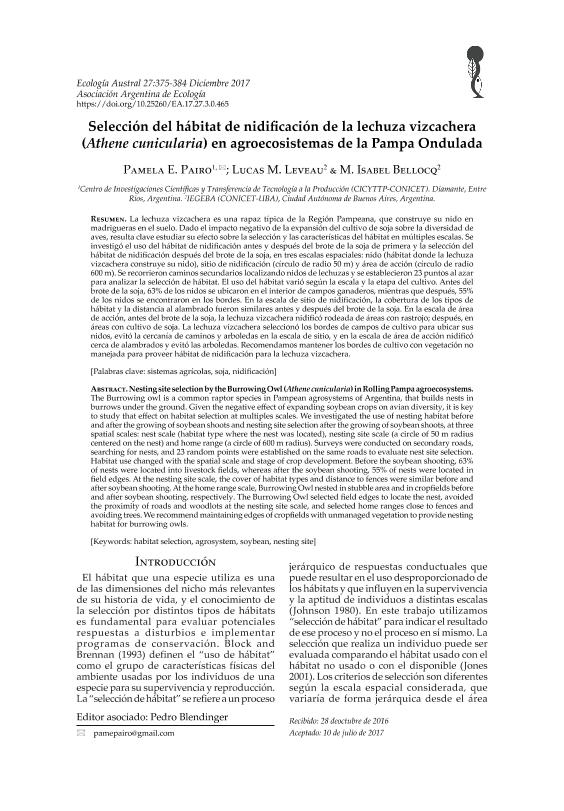Artículo
La lechuza vizcachera es una rapaz típica de la Región Pampeana, que construye su nido en madrigueras en el suelo. Dado el impacto negativo de la expansión del cultivo de soja sobre la diversidad de aves, resulta importante estudiar su efecto en la selección y en las características del hábitat a múltiples escalas. Se estudió el uso del hábitat de nidificación antes y después del brote de la soja de primera y la selección del hábitat de nidificación después del brote de la soja a tres escalas espaciales: nido (hábitat donde la lechuza construye su nido), sitio de nidificación (círculo de radio 50 m) y área de acción (círculo de radio 600 m). Se recorrieron caminos secundarios localizando nidos de lechuzas y establecimos puntos al azar para analizar la selección de hábitat. El uso del hábitat varió según la escala y etapa del cultivo de soja. Antes del brote de la soja el 63% de los nidos se localizaron en el interior de campos ganaderos, mientras que después el 55% de los nidos se encontraron en los bordes. A la escala de sitio de nidificación, la cobertura de los tipos de hábitat y la distancia al alambrado fueron similares antes y después del brote de la soja. A escala de área de acción, antes del brote de la soja la lechuza vizcachera nidificó rodeada de áreas con rastrojo, mientras que después nidificó en áreas con cultivo de soja. La lechuza vizcachera seleccionó los bordes de campos de cultivo para ubicar sus nidos, evitó la cercanía de caminos y arboledas a escala de sitio y a la escala de área de acción nidificó cerca de alambrados evitando las arboledas. Recomendamos mantener los bordes de cultivo con vegetación no manejada para proveer hábitat de nidificación para la lechuza vizcachera. The Burrowing owl is a common raptor species in Pampean agrosystems of Argentina, that builds nests in burrows under the ground. Given the negative effect of expanding soybean crops on avian diversity, it is key to study that effect on habitat selection at multiples scales. We investigated the use of nesting habitat before and after the growing of soybean shoots and nesting site selection after the growing of soybean shoots, at three spatial scales: nest scale (habitat type where the nest was located), nesting site scale (a circle of 50 m radius centered on the nest) and home range (a circle of 600 m radius). Surveys were conducted on secondary roads, searching for nests, and 23 random points were established on the same roads to evaluate nest site selection. Habitat use changed with the spatial scale and stage of crop development. Before the soybean shooting, 63% of nests were located into livestock fields, whereas after the soybean shooting, 55% of nests were located in field edges. At the nesting site scale, the cover of habitat types and distance to fences were similar before and after soybean shooting. At the home range scale, Burrowing Owl nested in stubble area and in cropfields before and after soybean shooting, respectively. The Burrowing Owl selected field edges to locate the nest, avoided the proximity of roads and woodlots at the nesting site scale, and selected home ranges close to fences and avoiding trees. We recommend maintaining edges of cropfields with unmanaged vegetation to provide nesting habitat for burrowing owls.
Selección del hábitat de nidificación de la lechuza vizcachera (Athene cunicularia) en agroecosistemas de la Pampa Ondulada
Título:
Nesting site selection by the Burrowing Owl (Athene cunicularia) in Rolling Pampa agroecosystems
Fecha de publicación:
11/2017
Editorial:
Asociación Argentina de Ecología
Revista:
Ecología Austral
ISSN:
0327-5477
Idioma:
Español
Tipo de recurso:
Artículo publicado
Clasificación temática:
Resumen
Palabras clave:
Selección de Hábitat
,
Agroecosistema
,
Lechuza Vizcachera
,
Soja
,
Nidificación
Archivos asociados
Licencia
Identificadores
Colecciones
Articulos(IEGEBA)
Articulos de INSTITUTO DE ECOLOGIA, GENETICA Y EVOLUCION DE BS. AS
Articulos de INSTITUTO DE ECOLOGIA, GENETICA Y EVOLUCION DE BS. AS
Citación
Pairo, Pamela Eugenia; Leveau, Lucas Matias; Bellocq, Maria Isabel; Selección del hábitat de nidificación de la lechuza vizcachera (Athene cunicularia) en agroecosistemas de la Pampa Ondulada; Asociación Argentina de Ecología; Ecología Austral; 27; 3; 11-2017; 375-384
Compartir
Altmétricas




